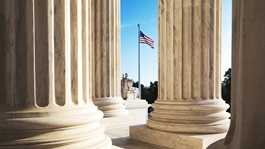In a comprehensive 22-page decision issued on November 12, the Fifth Circuit Court of Appeal upheld its stay of federal OSHA's COVID "vaccine-or-test" Emergency Temporary Standard (ETS) and found merit in the numerous petitioners' procedural and substantive challenges to its issuance and effects.
The court addressed whether petitioners were likely to succeed on the merits of their claim that OSHA exceeded its statutory authority. The court concluded they were, observing that OSHA was not able to prove any of the statutory requirements—(1) that COVID-19 was a "new hazard"; (2) that employees were exposed to the hazard; (3) that exposure posed a "grave danger" to these employees; or (4) that the ETS was "necessary" to combat such a hazard.
COVID was not an "emergency" or "new hazard" according to the court because the "entire globe has now endured [the pandemic] for nearly two years…." Moreover, OSHA's prior litigation position—during the Trump Administration, when OSHA declined to issue an ETS— that COVID was a "recognized hazard" was repeatedly cited by the court as grounds to undermine the current OSHA litigation posture.
Regarding the "exposure" requirement, the court held that OSHA could not prove that COVID was present in every covered workplace or workforce. Moreover, "grave danger" was absent inasmuch as OSHA has described the effects of COVID as only "mild" to "critical." The court also cited current vaccination rates as further evidence that COVID was not a "grave danger" because of the protection provided to the inoculated by the vaccines.
In a passage of the opinion likely to stoke controversy, the court found that President Biden's initial public opposition to a vaccination mandate (in December 2020, when he was President-elect) undermined the alleged gravity of the danger, and the "retweet" by his chief of staff of a reporter's tweet that the vaccination mandate was "the ultimate workaround for the Federal gov't to require vaccinations" showed that the mandate was a pretext to hide the agency's unlawful actions.
The court also rejected OSHA's arguments for the necessity of the ETS, finding the ETS to be both overbroad in that it failed to distinguish among workplaces with different risk levels and under-inclusive in that the 100-employee threshold left unprotected workers at many workplaces. Again, the court cited OSHA's prior statements about the lack of flexibility inherent in a standard, as compared with industry-specific guidance that could be modified as more is learned about the virus.
The Fifth Circuit went on to identify two primary constitutional concerns with the ETS. First, the mandate regulates "noneconomic inactivity traditionally within the States' police power," and therefore far exceeds the federal government's authority to promulgate laws under the Commerce Clause. As the court stated, "[a] person's choice to remain unvaccinated and forgo regular testing is noneconomic inactivity," and "to mandate that a person receive a vaccine or undergo testing falls squarely within the States' police power."
Second, the court found that the ETS exceeds the bounds of OSHA's narrow statutory authority delegated by Congress. Citing the US Supreme Court's decision that "health agencies do not make housing policy," the Fifth Circuit similarly determined that "occupational safety administrations do not make health policy."
At bottom, the court explained that an OSHA ETS is intended to be a "delicate exercise" of "extraordinary power," and one used only sparingly. By contrast here, the Fifth Circuit describes the ETS as "a one-size-fits-all sledgehammer that makes hardly any attempt to account for differences in workplaces (and workers) that have more than a little bearing on workers' varying degrees of susceptibility to the supposedly 'grave danger' the Mandate purports to address."
It remains unclear whether or when the Judicial Panel on Multi-District Litigation will endeavor to consolidate the various ETS challenges filed in multiple circuits and assign the matters by lottery to one circuit for further proceedings. Additionally, even if that occurs, it is unknown whether it will affect the Fifth Circuit's stay order in the near term.
Special thanks to law clerk Michelle Avidisyans (Los Angeles) for her assistance in the preparation of this content.



